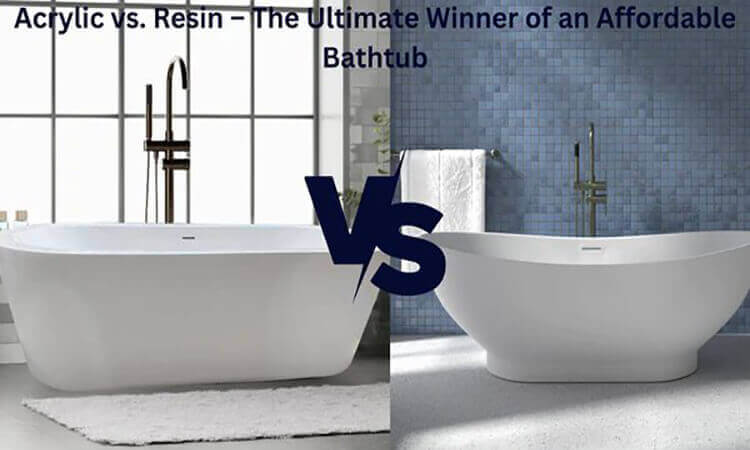When it comes to selecting the perfect bathtub for your bathroom renovation, solid surface bathtubs might be an option you've heard about. However, their higher price tag might give you pause. So, is it worth spending the extra dollars to buy a solid surface bathtub? Let Giving Tree Home delve into the pros and cons, starting with resin stone bathtubs.
What is a Solid Surface Bathtub
Solid surface bathtubs available on the market today can be classified into two types based on materials: pure acrylic solid surface bathtubs and composite bathtubs made of acrylic, natural stone, polymer resin, and mineral compounds (varies depending on manufacturer formulations), also known as stone resin bathtubs.
There might be a misconception that pure acrylic solid surface bathtubs are the same as acrylic bathtubs, but this is incorrect. The main difference lies in the manufacturing process. Acrylic bathtubs typically involve softening acrylic sheets and molding them onto mold walls through techniques like compressed air or vacuum suction, meaning they are hollow inside. On the other hand, pure acrylic solid surface bathtubs are formed by pouring and cooling molten acrylic material in molds, resulting in a solid structure. Here's a comparison:
- Acrylic Bathtubs: Hollow inside, made with acrylic sheets.
- Solid Surface Bathtubs: Solid inside, made with pure acrylic or acrylic composite materials.
In terms of pricing, the order typically is: Pure Acrylic Solid Surface Bathtubs > Stone Resin Bathtubs > Acrylic Bathtubs.
Now, let's dive into understanding acrylic:
Acrylic, also known as polymethyl methacrylate (PMMA), is a transparent thermoplastic polymer formed by polymerization reactions of methyl methacrylate and other monomers. Its excellent durability, weather resistance, and chemical resistance make it a popular material for bathtubs.
Advantages of Solid Surface Bathtubs
Durability
As mentioned earlier, solid surface bathtubs are solid, which means they have stronger impact resistance compared to traditional ceramic or hollow-material bathtubs. While the reliability of solid surface bathtubs may not match that of cast iron bathtubs, users can repair minor surface defects like yellowing or scratches themselves, such as by sanding, ensuring your solid surface bathtub stays fresh for 10-15 years.
Easy Maintenance
Firstly, the bathtub surface is non-porous, meaning dirt has nowhere to hide, making stains more visible and cleaning easier and more efficient. Additionally, with surfaces polished and treated for stain resistance, solid surface bathtubs virtually eliminate the growth of bacteria and mold, ensuring user health. For routine maintenance, solid surface bathtubs are not picky. Using regular neutral cleaning agents, such as mild soap and water, can easily wipe the bathtub surface, keeping it clean and shiny.
Variety of Styles
Because solid surface bathtubs are cast, manufacturers only need to customize corresponding molds for different styles, giving them greater flexibility and customization. Moreover, as one of the mainstream options, the number of manufacturers producing solid surface bathtubs is increasing, providing consumers with more choices and possibilities. Whether you prefer traditional classic designs or modern trendy styles, you can find a solid surface bathtub to suit your taste on the market. From sleek minimalism to retro nostalgia, from smooth lines to intricate carvings.
Insulation
For those who enjoy relaxing and indulging in a pleasant bath, a bathtub with good insulation can make the bathing experience more comfortable and long-lasting.
Generally, cast iron bathtubs are considered to have excellent insulation due to their high density and good thermal conductivity. However, to ensure its insulation effect, multiple layers of structure or a layer of insulation coating on the surface are needed.
While solid surface bathtubs may not have the insulation performance of cast iron bathtubs, they rank well among other materials due to their high material density. However, it's worth noting that when using a solid surface bathtub, one should not rush to add hot water, as there is a risk of cracking, but instead, should gradually adjust.
Disadvantages of Solid Surface Bathtubs
Heavy Weight
This is understandable, as solid surface bathtubs are solid and made of high-density materials, which may make them heavier than other types of bathtubs. Furthermore, to ensure the bathtub's stability and durability, it is usually designed with reinforced bottoms, thick edges, and internal support structures. Some users prefer to soak in the bathtub for a long time, so the solid surface bathtub they choose may contain built-in fillers, further increasing the bathtub's weight.
Expensive
Solid surface bathtubs are typically considered a higher-end bathtub style, often more expensive than other types of bathtubs. According to some surveys we conducted on Wayfair, solid surface bathtubs are priced at around $1800, while cast iron bathtubs range from $1500 to $2000, acrylic bathtubs from $500 to $700, stone bathtubs from $6000 to $7000, and GRP bathtubs from $700 to $800.
Ending
In conclusion, solid surface bathtubs do have some drawbacks, such as their high price and relative bulkiness. However, they also offer advantages such as durability and aesthetics, making them a widely used type of bathtub. If you are hesitating about whether to choose a solid surface bathtub, you can consider your personal needs and weigh the pros and cons. If you cannot afford the high price of solid surface bathtubs, you may consider Giving Tree's acrylic bathtub series. These bathtubs offer a more affordable option while maintaining quality, providing you with better value for your money.




